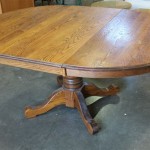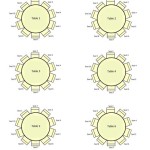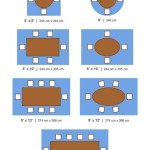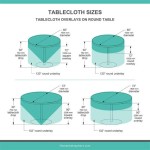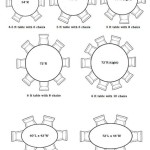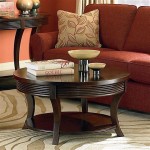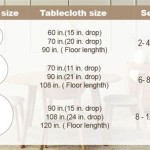Is A Round Or Square Table Better For Small Spaces?
Choosing the right table for a small space can significantly impact the room's functionality and aesthetics. A well-selected table can maximize space utilization and create a more comfortable and inviting environment. Conversely, an ill-fitting table can clutter the room, hinder movement, and make the space feel cramped. The decision between a round table and a square table often arises when furnishing smaller areas, and both options present their own set of advantages and disadvantages that should be carefully considered.
Numerous factors contribute to determining the ideal table shape for a specific small space. These include the room's dimensions, the intended use of the table, the number of people it needs to accommodate regularly, and the existing furniture and décor. Understanding these elements is crucial to making an informed decision that optimizes the space and meets individual needs.
This article delves into the comparative analysis of round and square tables in the context of small spaces. It explores the pros and cons of each shape, considering factors such as space efficiency, seating capacity, visual impact, and overall functionality. By examining these aspects, readers can gain a comprehensive understanding of which table shape is best suited to their particular small space.
Space Efficiency and Foot Traffic
One of the primary concerns in small spaces is optimizing every square inch available. In terms of space efficiency, round tables often present a distinct advantage. Their circular shape allows for smoother traffic flow around the table, as there are no sharp corners to navigate. This can be particularly beneficial in tight spaces where maneuvering can be challenging.
The absence of corners also means that round tables generally occupy less visual space than square tables. This can make a small room feel less cluttered and more open. The eye naturally flows around the curved edges of a round table, creating a sense of spaciousness. In contrast, the sharp corners of a square table can create a sense of confinement, especially in an already limited area.
Square tables, on the other hand, can sometimes be more efficient when placed against a wall. The straight edge allows the table to sit flush against the wall, maximizing the usable space in the center of the room. However, this configuration typically limits the table's seating capacity and functionality. It transforms the table into more of a console or side table rather than a primary dining or work surface.
Ultimately, the space efficiency of a round versus square table depends on the specific layout of the room and the intended use of the table. If the table is intended for dining and needs to accommodate multiple people, a round table may be the better choice due to its improved traffic flow and visual lightness. However, if the table is primarily for occasional use and needs to be placed against a wall to maximize space, a square table might be more suitable.
Seating Capacity and Arrangement
Seating capacity is another crucial consideration when selecting a table for a small space. While both round and square tables can accommodate varying numbers of people, their seating arrangements differ significantly.
Round tables typically offer more flexibility in terms of seating. Chairs can be easily added or removed around the table as needed, and guests can sit closer together without feeling cramped. This makes round tables ideal for small gatherings and intimate meals. The circular shape also encourages conversation and creates a more inclusive dining experience, as everyone can easily see and interact with each other.
Square tables, in contrast, tend to have a more rigid seating arrangement. The corners can limit the number of chairs that can be comfortably placed around the table, especially in a small space. While a square table can accommodate four people comfortably, adding extra chairs can make the seating feel cramped and uncomfortable.
However, square tables can be advantageous when it comes to maximizing seating along walls. Benches or banquettes can be placed along one or two sides of the table, providing ample seating while minimizing the table's footprint. This configuration can be particularly useful in breakfast nooks or other small dining areas.
In summary, if the table needs to accommodate a flexible number of people and foster a more inclusive dining experience, a round table is often the better choice. However, if seating along walls is a priority, a square table may be more suitable.
Aesthetics and Visual Impact
The aesthetic impact of a table can significantly influence the overall ambiance of a small space. Both round and square tables offer distinct visual characteristics that can complement or detract from the room's décor.
Round tables tend to create a softer, more inviting atmosphere. Their curved lines and lack of sharp edges contribute to a sense of harmony and flow. Round tables can also make a small room feel less formal and more relaxed. These tables often work well with softer palettes, curved furniture, and natural materials. This gives the space a comfortable vibe and is considered aesthetically pleasing.
Square tables, on the other hand, can add a touch of formality and structure to a space. Their straight lines and sharp corners create a more defined and organized look. Square tables can also be used to create a sense of balance and symmetry in a room. Often, square tables work particularly well in more modern and minimalist designs. With their strong lines, they can add an architectural element to the space.
The choice between a round and square table should also consider the existing furniture and décor in the room. If the room already features a lot of sharp angles and straight lines, a round table can help soften the overall look. Conversely, if the room is dominated by curved shapes, a square table can provide a welcome sense of contrast.
Beyond shape, the material and style of the table also play a crucial role in its aesthetic impact. Lighter materials and minimalist designs can help a table blend into a small space, while darker materials and more ornate designs can make a table stand out as a focal point.
Specific Room Considerations
Beyond the general advantages and disadvantages of each shape, the specific room in which the table will be placed is critical. For example, a round table might be ideal for a small breakfast nook where the primary goal is to create a cozy and intimate dining area. The circular shape encourages conversation and allows for easy movement around the table.
In a small living room or studio apartment, a square table might be more suitable if it needs to serve multiple purposes. It can be used as a dining table, a work surface, or even a side table. The straight edges allow it to be easily pushed against a wall when not in use, freeing up valuable floor space.
The shape and size of the room should also be taken into account. In a long and narrow room, a round table can help break up the linear flow and create a sense of visual interest. However, in a square room, a square table might be more appropriate as it mirrors the room's shape and creates a sense of harmony.
Additionally, the presence of other furniture and architectural features should be considered. If the room already has a strong focal point, such as a fireplace or a large window, the table should be chosen to complement, not compete with, that focal point. In some cases, a smaller, more understated table might be the best option.
Multipurpose Functionality and Adaptability
In many small spaces, furniture needs to be versatile and adaptable to different needs. A table that can serve multiple purposes is a valuable asset in a limited area. Both round and square tables can be adapted for various functions, but their strengths lie in different areas.
Round tables are often well-suited for social gatherings and activities. The circular shape encourages interaction and makes it easy for everyone to participate in games, crafts, or shared meals. A round table can also be easily converted into a workspace by adding a laptop and a few accessories.
Square tables, on the other hand, can be more practical for tasks that require a flat, stable surface. They are ideal for writing, drawing, or working on projects that involve multiple documents or materials. A square table can also be used as a buffet table or a serving station during parties. In a small kitchen, a square table can even function as extra counter space when needed.
Some tables are designed with features that enhance their multipurpose functionality. Drop-leaf tables, for example, can be expanded or collapsed to accommodate different needs. Tables with built-in storage compartments can also be useful for keeping clutter at bay and maximizing space utilization.
In choosing between a round or a square table from a functional standpoint, consider how the table will be used most frequently. If it will primarily be used for social activities, a round table might be the better choice. If it will primarily be used for work or tasks that require a flat surface, a square table might be more suitable.

Round Or Square Dining Tables For Small Spaces Modish Living

Dining Room Tables Round Vs Rectangular

So What Is The Best Shape Of Dining Table For A Small Space First You Need To Round Rectangle Kitchen

Is It Good To Have A Round Or Square Dining Table

Why A Round Dining Table Might Be Your Best Option Abide Interiors

Why You May Need A Round Dining Table The Decorologist

Six Of The Best Small Space Dining Tables Bright Bazaar By Will Taylor

9 Small Dining Room Ideas That Serve Up Style Living Spaces

Useful Dining Room Size Guide In 5 Easy Steps Urvission Interiors

Simple Rules For Dining Room Rugs Floorspace
Related Posts

